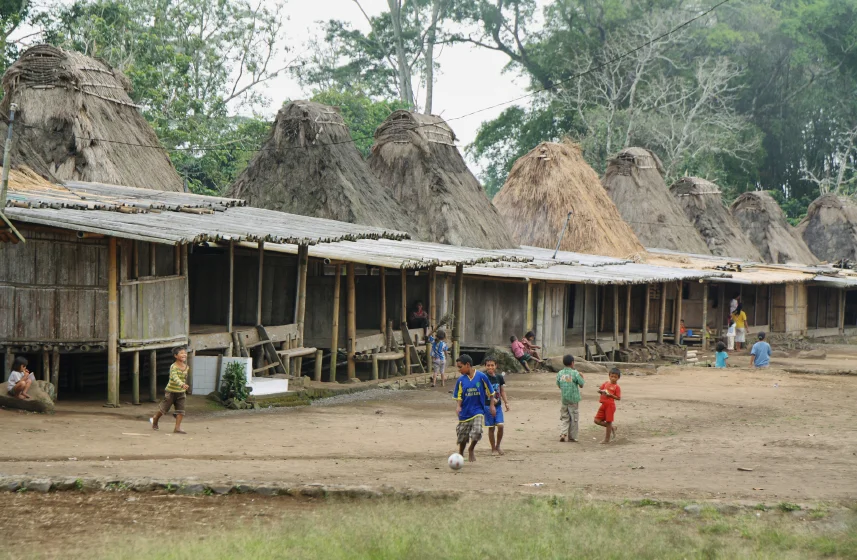Map courtesy of www.theodora.com/maps, used with permission
Facts in brief
Indonesia consists of five main islands in a group of more than 17 000. A group of islands like this is called an archipelago (say arc-uh-pel-ego).
The Indonesian archipelago stretches almost 5000 kilometres from the Asian mainland into the Pacific Ocean and covers an area of about 1 919 443 square km.
Less than 6000 of the islands are inhabited.
The largest island is Sumatra, but the island of Java has the highest population. Kalimantan, West Papua (until recently called Irian Jaya) and Sulawesi are the other main islands.
Population
About 252 million people live in Indonesia. There are 300 ethnic groups and 365 different languages or dialects are spoken. The main ethnic groups are Javanese, Sundanese, Indonesian (Malay), Maduresa.
The Indonesian Coat of Arms (official badge) © Getty Images
The main religions are Islam (more than 80%), Christianity, Hinduism, and Buddhism.
Official language: Bahasa Indonesia
Official name: Republic of Indonesia
The name Indonesia has been derived from two Greek words "Indos" and "Nesos", meaning Islands near India.
Capital city: Jakarta (Nearly 10 million people live in the capital city)
Jakarta is the capital city © iStock image
Type of government: republic with a president as both the head of state and the head of government.
Money is the Rupiah (1 rupiah (Rp) is divided into 100 sen)
Main industries: fishing, petroleum, timber, paper products, cotton cloth, tourism, mining of petroleum, natural gas, bauxite, coal and tin, tourism.
Indonesia exports (sells to other countries) oil and gas, electrical goods, textlies and rubber.
Main farm products: rice, soy beans, bananas, coffee, tea, palm, rubber, sugar cane, poultry, pork, and eggs.
Time difference from Australian Eastern Standard Time: Jakarta is three hours behind.
Climate and rainfall
The climate of Indonesia is tropical: hot, wet and humid. The temperature range on the coasts is between 24ºC and 28º C for most of the year. Strong winds called monsoons bring heavy rain in the wet season from December to March. There is less rain June between and September.
Physical features
Indonesia has many high mountains, the highest of which are over 4000 metres. The highest is Puncak Jaya (5029 metres) on Irian Jaya (also called West Papua).
Many of the mountains are active volcanoes. There are tropical rainforests and jungles, as well as swampy mangrove areas. Indonesia's most fertile land is on the island of Java.
The Indonesian national flag
Read other kidcyber pages about Indonesia: food, clothing, farming, housing, religions, transport, and Jakarta, capital city of Indonesia.
Find them here
Read the kidcyber page:
Watch a video of three young men travelling in Indonesia. Look for:
The different ways they travel about.
How and where they shop for food?
Things they enjoy doing in Indonesia.
Games they play.
Some kinds of houses they see.
Through Indonesia from Martin Friedrich on Vimeo.
A brief history of Indonesia
Fossil remains suggest that humans have lived on the islands of Indonesia for more than
500 000 years. For thousands of years the islands to the north were populated by native
people. Some lived inland growing crops, while others near the coasts fished and traded
by sea. People from Sulawesi sailed south to Northern Australia where they traded metal
tools and pottery with Aboriginal peoples.
Chinese, Indians and Arabs brought religion
Later, Chinese and Indian traders visited the islands. Indian teachers brought their
Hindu religion to the islands. In the 7th century there were powerful Hindu and
Buddhist kingdoms and empires in the islands. Later, around 1100 AD, Arab traders
brought the religion of Islam to the islands. Today Hinduism is the main religion on
Bali, but most Indonesians elsewhere are Muslims.
Indonesia is known as the Spice Islands
From 1500 Europeans from Portugal, Spain, Netherlands and England fought each other for control of the islands and the spices that grew there. For awhile the islands of
Indonesia were known as the 'Spice Islands'. The Dutch, who finally won and took control,
ruled Indonesia for 350 years.
Indonesia becomes and independent republic
The people of the islands hated the Dutch who grew rich growing coffee and exporting
spices. In the 1920s the Indonesians began fighting the Dutch, and when the Japanese
invaded the islands during World War II they drove the Dutch out. In 1949 Dutch finally
left and Indonesia became an independent republic, with a government elected by the
people. The head of state was the first President and his name was Sukano.






